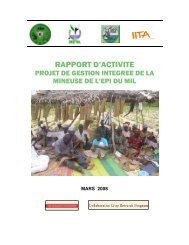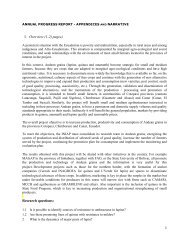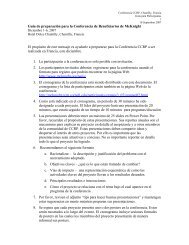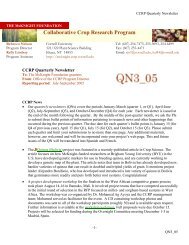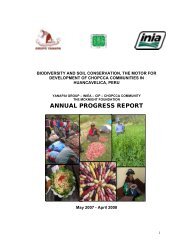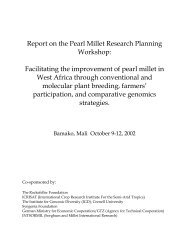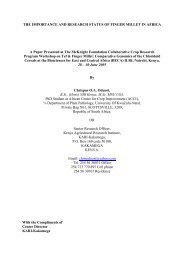English - McKnight Foundation Collaborative Crop Research Program
English - McKnight Foundation Collaborative Crop Research Program
English - McKnight Foundation Collaborative Crop Research Program
Create successful ePaper yourself
Turn your PDF publications into a flip-book with our unique Google optimized e-Paper software.
<strong>McKnight</strong> <strong>Foundation</strong> <strong>Collaborative</strong> <strong>Crop</strong>s <strong>Research</strong> Project No: 06-741<br />
Introduction:<br />
The rainfall amount and distribution during the 2008/09 season was poor in most dry areas of Tanzania.<br />
Also there was an outbreak of cut warms at seedling stage especially in Singida, where farmers had to<br />
re-plant legumes more than twice until they ran out of seed. This has led to poor harvest of the crop. The<br />
two outputs 1.1 and 1.2 mentioned below were covered in year one and year 2.<br />
Output 1.1: Producer and consumer preferences for traits in cowpea identified<br />
This out put has been completed in year two<br />
Output 1.2: Capacity of cowpea farmers, especially women enhanced<br />
Three new more farmer groups were formed this season, one from each district of Singida, Dodoma and<br />
Iringa. These are from Nduu village (21 members) in Singida, Mpunguzi (10 members) in Dodoma and<br />
Ilambilole (8 members) in Iringa. Some preliminary training has been undertaken, mainly group<br />
formation, seed production and processing and utilization of cowpea.<br />
Output1.3.0: Cowpea lines resistant to A. vogelii identified<br />
1.3.1: To assemble cowpea germplasm:<br />
The collection of cowpea germplasm was conducted in year one, where cowpea accessions were<br />
obtained from IITA, Bihawana farmers Training Centre, National Pant Genetic Resource Centre and<br />
Ilonga Agricultural <strong>Research</strong> Station. These were evaluated for adaptability and Alectra resistance<br />
starting in the same year one.<br />
1.3.2 On-station screening of cowpea cultivars for Alectra resistance<br />
Introduction: Cowpea (Vigna unguiculata) is a crop of major importance to the nutrition of poor rural<br />
households in the drier and sub-humid regions of Eastern and Southern Africa, where diets tend to be<br />
overly reliant on starchy foods such as millet, sorghum, maize and cassava. Cowpea grain is an<br />
inexpensive, high quality source of protein and its vitamin-rich leaves are eaten as spinach. Women<br />
particularly value cowpeas, which help them to bridge the "hunger months" prior to the main cereal<br />
harvest, also it adds cash to the household after selling the grain, dried leaves and cookies like bagia<br />
(buns). Farmers grow local long duration cowpea cultivars, which produce low yield due to a number of<br />
reasons including Alectra infestation. In odder to improve the productivity of cowpeas in these areas,<br />
there was a need to introduce cowpea cultivars, which are high yielding, resistant to pests including<br />
Alectra and preferred by consumers both for market and for household use. The introduction of<br />
accessions was to asses for their resistance to Alectra. This activity started by this project in 2006/2007<br />
growing season and the promising lines were tested to more Alectra infested sites. These sites were<br />
Ismani in Iringa region; Bihawana Farmer Training Centre and Hombolo <strong>Research</strong> station both in<br />
Dodoma. For the second season 2007/2008 the cowpea lines were again planted at the same sites of<br />
Ismani, Bihawana FC and Hombolo to confirm their performance in terms of Alectra resistance and<br />
yield. Promising lines for Alectra resistance and yield were identified. In the third season 2008/2009, the<br />
promising lines were planted again at these Alectra hot spots for further confirmation of resistance to<br />
Alectra and for yield performance.<br />
Material and methods: The trial was planted at three on station locations which included Ismani,<br />
Bihawana Training Centre and Hombolo research station. Cowpea lines planted were those from last<br />
season showing promising Alectra resistance and farmers had already selected some of them as the best<br />
lines. These lines included IT99K-21-7-2-2-1, IT99K-573-1, IT97K-818-35, IT89KD-288, TZA 263,<br />
IT97K-819-118, IT97K-499-8, IT97K-499-38, IT00K-1207, B301 and VULI-2, FAHARI as local<br />
checks. The materials were planted at a plot size of 3x4m, 4 rows per plot and replicated four times.<br />
Data recorded were plant stand count at harvest, Alectra count per plot and yield per plot (g/plot). Yield<br />
data was computed to yield in kg per ha.<br />
3<br />
2009



